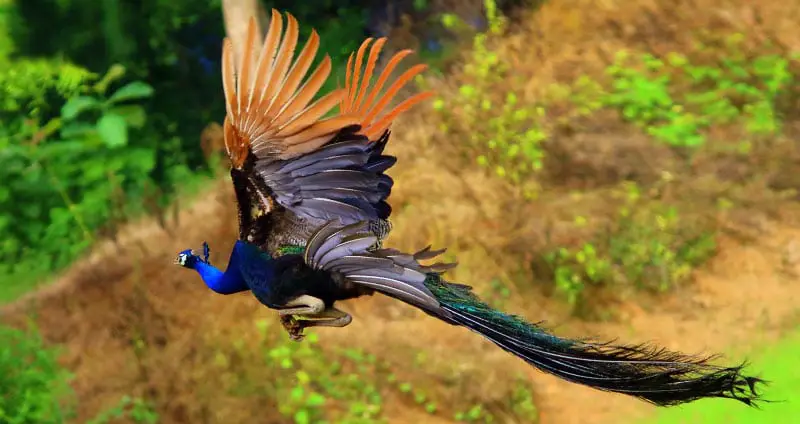Peacocks are the pinnacle of beauty in the avian world. These stunning creatures have developed appearances that make people stop and marvel at them for a bit.
While many people have seen peacocks at some point, almost nobody actually sees them fly — they’re always walking around. Although they’re birds and have sizeable wings, are peacocks flightless? Destined to sit pretty their whole lives?
Table of Contents
Can Peacocks Fly?
Yes, peacocks can fly — although they can’t fly like normal birds. Peacocks are able to fly short distances, like up into a tree or on top of a building, and gently flutter/glide back down.
They aren’t able to fly for sustained periods of time, though. You won’t see peacocks soaring through the air hundreds of feet above your head.
So, why don’t peacocks fly like other birds? Is it because their massive tail gets in the way, or is there another reason? The answer’s actually surprising.
Quick Note About The Peacock Name
Before we go further, it needs to be addressed that a peacock is actually the name of a male peafowl, while female peafowls are called peahens.
Peacocks are the ones with massive tail feathers and very bright colors (the more attractive of the two) so people usually end up calling both sexes of peahens “peacocks”.
For simplicity’s sake, we’ll continue answering the question in relation to peacocks and make the distinction when necessary.
Are Peacocks Not Meant To Fly?
While peacocks are able to fly short distances, is this because they’re birds that simply aren’t meant to fly?
This is not a bad assumption to make. Physically, peacocks look like many different flightless birds. They have large, strong legs, sizeable bodies, and clawed toes — traits that make them look like they’re made to live on the ground.
However, this isn’t the case.
Peacocks are actually memebers of the Phasianidae family which is made up of heavy, ground-dwelling birds. Popular members of this family include chickens, turkeys, pheasants, and partridges.
While they spend most of their time on the ground, foraging for food and walking from place to place, they all have the ability to fly (to varying degrees).
So, peacocks are actually meant to fly, and they’re not alone in their infrequent behavior.
Why Do Peacocks Fly So Infrequently?
If peacocks can fly, why in the world do they do it so infrequently? Isn’t flying extremely beneficial?
In short, this behavior can be summed up by the fact that they simply don’t need to fly often.
First of all, this is a bird that’s great at living on the ground. They thrive off of fruits, seeds, insects, and small reptiles that they find on the ground, in addition to food scraps left behind by humans.
Flying around in search of food isn’t necessary.
Additionally, these birds are fast, with a top speed of around 10 mph thanks to their massive legs. This isn’t blazing speed, but it’s enough to get them away from dangerous situations quickly.
So, during the day peacocks don’t need to fly much. At night, though, is when they use their flying ability the most.
You’ll be hard-pressed to find a bird that sleeps on the ground — especially one that’s the size and color of a peacock. Some do, such as quail and sparrows, but many sleep up high to avoid predators lurking below.
At night, peacocks will use their short flight spurts to climb trees branch by brach up to a comfortable elevation. They may also glide from tree to tree. Then, in the morning, they glide back down.
Do Peacocks’ Tails Make It Hard To Fly?
When someone learns that peacocks can’t fly very far, their first thought is that it’s their massive tail that’s holding them back, and that’s not a bad guess!
A male peacock has a tail with less than two dozen feathers, but this tail is covered with a “train” of about 200 feathers that can reach about 6 feet in length. This has to get in the way, right?
Well, a study carried out at the Unviersity of Leeds’ School of Biomedical Sciences by Dr Graham Askew found this train to have almost no effect on a peacock’s ability to fly.
Peacocks were filmed taking off in flight with their train, and then filmed again with their train clipped. Dr Askew found no significant difference in take-off performance between the two states.
The train did double the amount of drag, but this is a very small factor to overcome.
This is complimented by the fact that peahens have very short trains yet still struggle to fly any significant distance.
Therefore, it can be assumed that peacocks have simply evolved to not fly as far — tail or no tail!

